The contact points between the rider and a bicycle are some of the most important aspects of riding a two-wheeled steed (think saddle, grips, pedals, and, yes, shoes). The bike footwear category has widened dramatically in the past few years to include everything from the highest-performance road shoes to versatile gravel kicks to flat pedal pumps designed for rugged mountain bike rides. After testing this year’s offerings, we hand-picked the following options that meet the needs of modern riders.
At A Glance
Gravel Shoes
Road Shoes
Mountain Bike Shoes
All gear in this guide was tested by multiple reviewers. When you buy through our links, we may earn an affiliate commission. This supports our mission to get more people active and outside. Learn more.
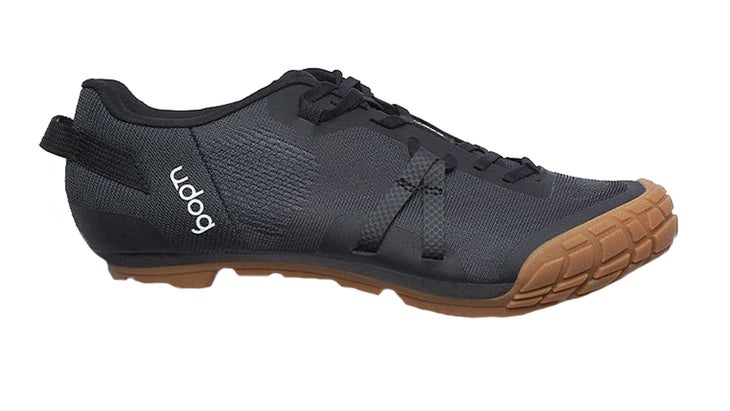
Best All-Day Gravel Shoe
Udog Distanza
Retention system: Laces
Available sizes: 38-48
Pros and Cons
⊕ Compliant, durable sole
⊗ Not easily adjustable while riding
While Italian-based Udog’s home base might be an ocean away from the birthplace of modern gravel cycling, its design team is leading the way in performance and comfort-focused creations. The Distanza is built to meet the demands of the all-day aspect of today’s gravel events with a compliant, walkable sole and highly breathable knit upper.
Design elements like 100-percent recycled polyester laces and a grippy rubber outsole distinguish the Distanza when a gravel ride becomes a hike-a-bike. The laces are routed through metatarsal support straps that aid in creating even tension along the foot, which reduces the hot spots that many standard lace-up shoes create.
We broke in the shoes for a few weeks before a 10-hour day on the bike at the Rock Cobbler gravel race. The 110-mile course with 10,000 feet of elevation and more than its fair share of muddy hiking is on the extreme side of our test rides, however, the Distanzas proved both durable and comfortable, with their flexible soles reducing foot fatigue.
Laces aren’t for everyone, and it’s worth noting the shoes run a bit big, so be sure to review the size guide to get the right fit. On the scales, our size 43s topped out at 702 grams, leaving our gram-conscious testers wishing for a bit of weight savings.
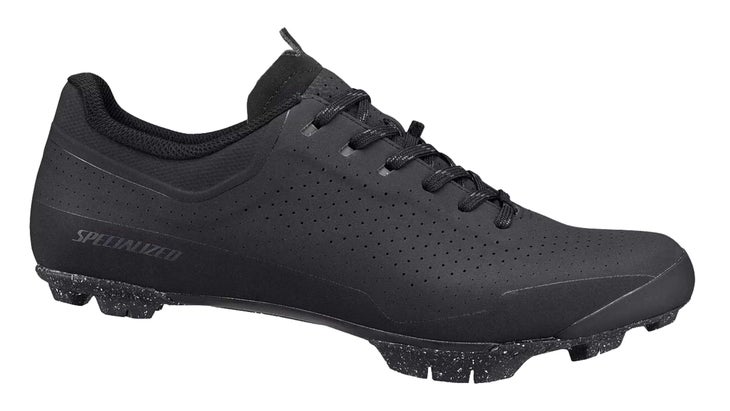
Most Versatile
Specialized Recon ADV
$225 at Backcountry $225 at Specialized
Retention system: Laces
Available sizes: 36-49
Pros and Cons
⊕ Stiff yet walkable carbon soles
⊗ Laces work well for some, but aren’t for everyone
The Specialized Recon ADV is designed for cranking out long miles on gravel roads. This lace-up model takes cues from the company’s Recon line of mountain bike shoes with its sleek look, but adds a splash of color and a stiffer carbon midsole with a bit of engineered flex in the forefoot. This forefoot flex makes the Recon ADV more walkable for mid-ride coffee stops and nature breaks.
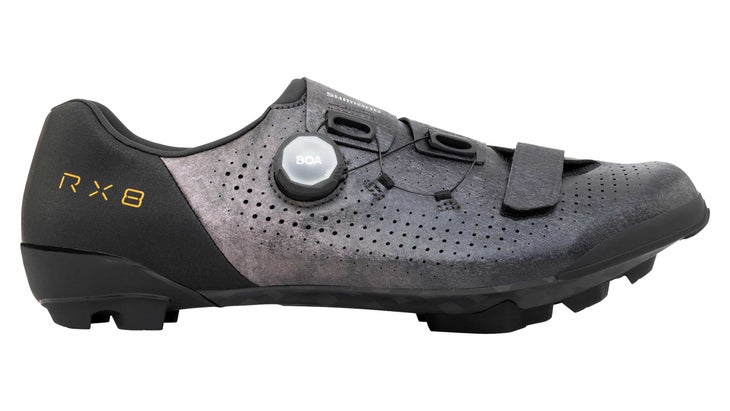
Most Accommodating Fit
Shimano RX801
$275 at REI $275 at Backcountry
Retention system: BOA dial and Velcro strap
Available sizes: 38-48 EU (half sizes from 41-45.5, wider width from 40-46)
Pros and Cons
⊕ Stiff carbon soles
⊕ Great fit
⊕ Easy to adjust while riding
⊗ Less walkable than others
Shimano has been a leader in the gravel race shoe category, and the RX801 only builds upon that legacy. The Japanese component brand recently gave these popular gravel kicks a makeover with improved ventilation, fit, and adjustability.
The synthetic upper is heavily perforated to increase airflow. Shimano also made the toe box wider and included heel stabilizers to keep the foot in place for greater control through the pedal stroke. A surround-wrapping upper hugs the foot for a close fit, while a rubberized Boa Li2 dial allows for micro-adjustments on the fly, which prevents the upper from getting too constrictive over the course of a long ride.
Have wide feet? No worries—the RX801 is available in a wide version in sizes 41-47.
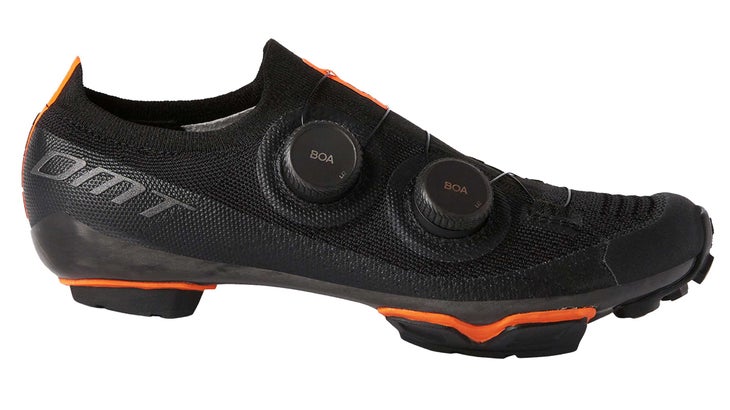
Best Gravel Race Shoe
DMT KM0
Retention system: Dual Boa Li2 dials
Available sizes: 37-47
Pros and Cons
⊕ Glove-like fit
⊗ Weak tread
DMT footwear is most recognizable attached to Tour de France powerhouse Tadej Pogacar. Now, the brand’s ingenuity and performance-oriented designs that earned two yellow jerseys on the road have made their way over to the gravel side of the sport.
A minimalistic knit upper and a shapely carbon sole are paired in the DMT KM0 for a glove-like fit with a focus on maximal stiffness (rated 10/10 by testers). During our first few rides, we noted the Michelin tread was extra grippy on short rough walks, however, after a few hundred miles of testing, a mile-long hike-a-bike wore the tread pretty quickly, leaving us slipping. At 542 grams (size 42), the KM0s are on the lighter side of the gravel shoe market.
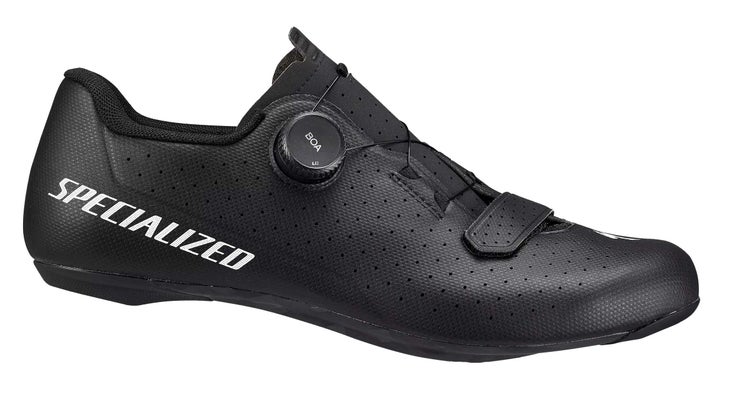
Best Value Road Shoe
Specialized Torch 2.0
$180 at Backcountry $180 at Competitive Cyclist
Retention system: Single Boa dial and toe strap
Available sizes: 36-49
Pros and Cons
⊕ A smart balance of performance and comfort
⊗ Minimal retention personalization
For riders looking for a performance road shoe but hesitant about diving head first into the high-end shoe market, the Torch 2.0 is a competitive option at the sub-$200 price point.
Though they’re designed for the recreational cyclist, our tester said he’d feel confident wearing them for a race. “They deliver an effective balance between comfort and performance,” he noted. “I do lengthy rides, often spending five or more hours in the saddle, and these shoes deliver comfort with minimal compromise in power transfer.”
The shoe has a fully perforated, single-layer synthetic and seamless upper with internal toe and heel reinforcement. This gives the Torch 2.0 a fairly supple fit with built-in, long-term shoe protection. A toe strap is paired with a single Boa dial. While we’d prefer a dual Boa dial to allow micro adjustments for a more personalized fit, the Torch 2.0’s configuration makes on-the-road adjustments possible. Our size 43s tipped the scales at 549 grams, a fair weight in this class of shoe.
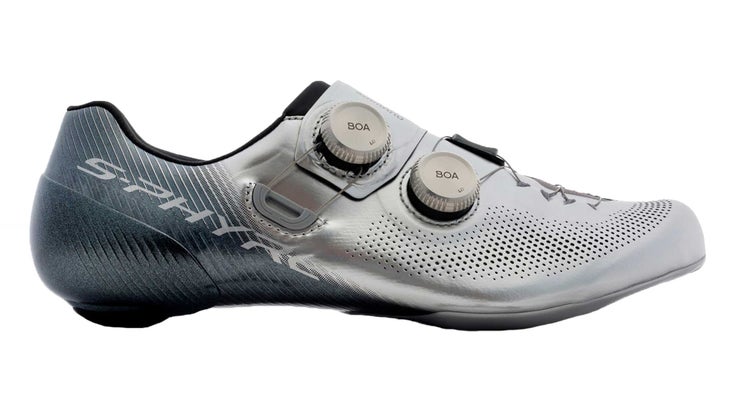
Best Everyday Road Shoe
Shimano RC903S
From $356 at Backcountry From $356 at Competitive Cyclist
Retention system: Dual Boa Li2 Metal Dials
Available sizes: 38-47
Pros and Cons
⊕ Supple, form-fitting upper
⊗ Hard to keep clean
Shozaburo Shimano would be proud to know the freewheel company he started in 1921 has grown to showcase a wide range of cycling components and gear for competitive and recreational riders alike, including high-performance cycling shoes like the RC903S, which falls within Shimano’s S-Phyre line.
Dual Boa metal dials lock a rider’s foot into the anti-twist heel cup with the help of the wrap-around upper and six points of retention over the front end of the foot. The carbon sole is strategically reinforced around the cleat for added power transfer while remaining compliant toward the heel for optimal stiffness—rated as 8/10 by our test team who altogether put more than 4,000 miles of riding in these shoes.
Perforated vents allow for sufficient heat dissipation through the upper’s thin material, and a pair of size 44 hit the scales at a meager 502 grams. On a warm, five hour day at the Mammoth Gran Fondo, the mix of engineered breathability and overall stiffness made for a positive experience.
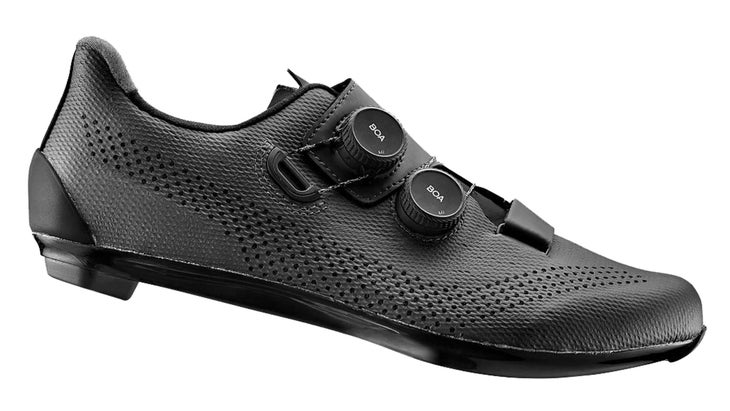
Best Performance Road Shoe
Giant Surge Pro
Retention system: Dual Boa Li2 dials and toe strap
Available sizes: 40-48
Pros and Cons
⊕ Stiff, performance-focused sole
⊗ Sole is too stiff for longer rides
As the largest bicycle manufacturer in the world, Giant has played a formative role in the modern cycling industry and always seems to be a step ahead of its competitors design-wise in just about every sector of the market. The Surge Pro, Giant’s flagship footwear offering, is just one example.
These shoes feature a three-point retention system, a unique carbon sole, and a weight of only 510 grams (size 43), making them an attractive option for performance-focused riders. A channel runs heel to toe along the sole, maximizing stiffness where it’s needed at the cleat—testers gave the shoes a 10/10 stiffness rating—delivering enhanced power transfer and cutting out excess carbon to save weight.
These were a top-rated shoe for high-intensity, hour-long criterium races, but on longer five-plus hour days, our feet needed relief from the extreme stiffness rating.
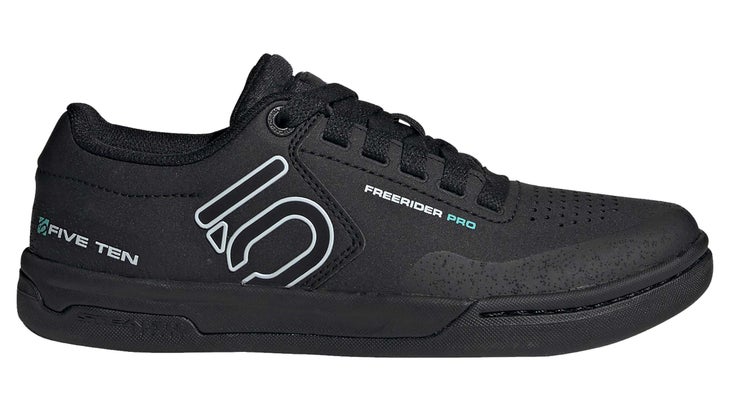
Most Versatile MTB Shoe
Five Ten Freerider Pro
$160 at REI (Women’s) $160 at REI (Men’s)
Retention system: Laces
Available sizes: 6-14.5 (men’s), 5-11 (women’s)
Pros and Cons
⊕ Easy-to-clean synthetic material
⊕ Stiff for optimized pedal performance
⊗ Lace capture causes laces to lay across the shoe
⊗ Tread pattern tends to retain mud
There’s a reason the Freerider Pro is the benchmark for all other flat-pedal mountain bike shoes. First, the wide toe box and cozy heel cup fit a wide range of feet, including my exceptionally fickle ones. More importantly, we’re huge fans of Five Ten’s famously grippy Stealth S1 Dotty rubber outsole—it keeps us solidly placed on the pedals on even the rainiest fays.
The Freerider Pro also shines with a stiff sole that leaves us feeling one with the pedal, resulting in excellent efficiency on longer rides. Lastly, the synthetic upper is durable and easy to clean when things get muddy. One tester loved them so much, she said the Freerider Pro is “still the master performance mountain bike flat pedal shoe that pedals all bikes and holds up throughout the season.”
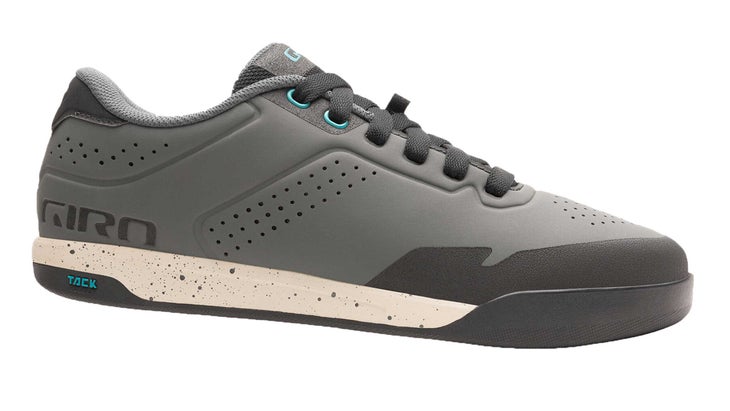
Best Lightweight MTB Shoe
Giro Latch
$150 at Backcountry (Women’s) From $90 at Backcountry (Men’s)
Retention system: Laces
Available sizes: 38-50 (men’s), 36-43 (women’s)
Pros and Cons
⊕ Very grippy
⊕ Lightest shoe in the lineup
⊕ More molded protection over toe box
⊗ Lace capture is flimsy
⊗ Slightly wider in heel
Giro’s Latch shoe fits, feels, and pedals a lot like the Five Ten Freerider Pro because of the stiff, flat sole that brings the foot closer to the pedal. Giro’s Tack Rubber and the irregular tread felt like it had the tackiest rubber of all the options we tested, and it shed mud more consistently than other tread patterns. The Latch’s quick-drying microfiber uppers were ideal for fall riding conditions, too.
At the end of the day, the Latch competes with the big guns in pretty much every metric of flat shoe performance. Plus, fashionable tester Megan Barton gives the Latch extra points for style.
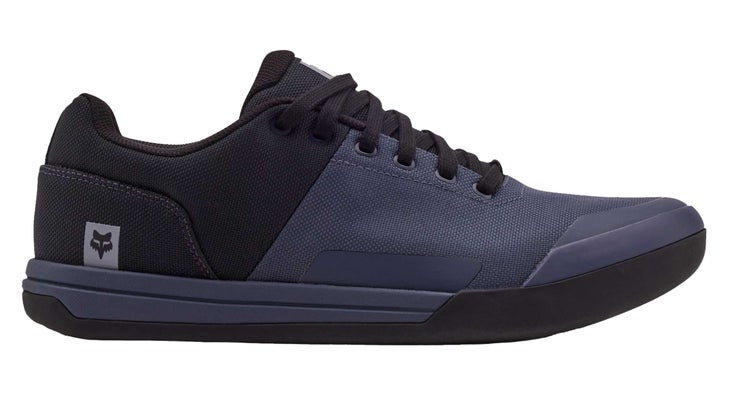
Best Protection
Fox Union Canvas
Retention system: Laces
Available sizes: 37-47 (unisex)
Pros and Cons
⊕ Robust and sturdy
⊕ Reinforced toe box
⊗ Heavy
⊗ Canvas was hard to clean
The Fox Union Canvas flat pedal riding shoe combines off-bike street style with solid on-bike performance. While we did not find the Ultratac rubber on the sole quite as grippy as Giro’s and FiveTen’s, it wasn’t far behind and still imparted a sense of durability while thrashing through local rock gardens in Hood River. The polyester canvas material also was not our favorite to clean, but it did provide robust weather protection during rainy, cold rides.
We liked how the shoe felt super stiff for pedal grip, but we would recommend it for shorter rides because we started to experience some foot fatigue around mile ten. Overall, this shoe has a nice low-profile design that we loved and excellent grip, and it would thrive from a short ride to a pub crawl.
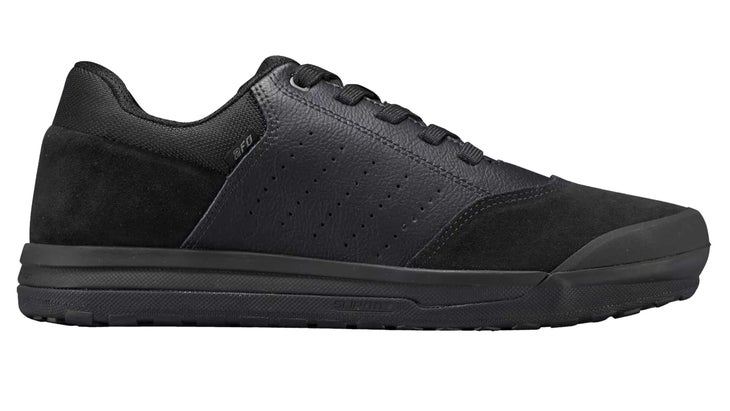
Best Grip
Specialized 2FO Roost Flat Syn Shoe
$50 at Backcountry $50 at Specialized
Retention system: Laces
Available sizes: 36-49 (unisex)
Pros and Cons
⊕ Matches grip with Stealth rubber
⊕ Stiff enough for long rides
⊗ Doesn’t feel as light as advertised
The 2FO Roost delivers top-notch grip, breathability, and comfort, making it one of our favorite flat pedal shoes in the Specialized line-up. The SlipNot ST rubber easily competes with the Five Ten’s Stealth rubber and seems to offer better grip in cold weather, especially when we needed to constantly transfer our power on the burliest, most technical trails.
In terms of stiffness, as a trail shoe it handled long descents like a champ with zero foot fatigue. The heel cup was nice, deep, and comfortably retentive, ensuring our heels stayed in place on rougher trails. Our only real complaint is that the shoe lacks protective padding in the toe box, which resulted in a few jammed toes.
This isn’t the best pick for those with narrow feet, but it’s a competitively priced top contender shoe for riders who like to punish themselves on epic missions.
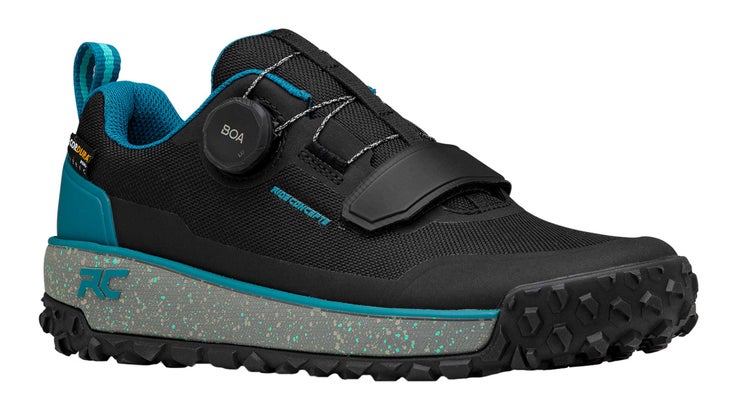
Most Comfortable MTB Shoe
Ride Concepts Flume BOA Flat Shoe
$190 at Jenson USA $200 at Ride Concepts
Retention system: BOA
Available sizes: 5-10 (women’s)
Pros and Cons
⊕ Super grippy
⊕ Exceptionally comfortable
⊕ BOA allows for easy micro-adjustments mid-ride
⊗ Balancing mid-shoe and heel tension a slight challenge
The Ride Concepts Flume BOA Flat is an easily adjustable and well-crafted shoe that feels like a slipper. Their Max Grip rubber sole offered exceptional grip—we felt comfortably glued to our pedals at all times, even on extremely technical and rooty trails.
Moreover, the toe and heel have hexagonal treads for confident hike-a-biking traction in slippery mud. The spacious toe box is comfortable, while the midsole support adds an overall feeling of being one with the pedals. “I loved how protected and secure I felt in these shoes,” said tester Annick Chalier. Our only gripe is that it was slightly challenging to get the tension with the BOA just right for our heels to be secure without the mid-shoe being too tight.
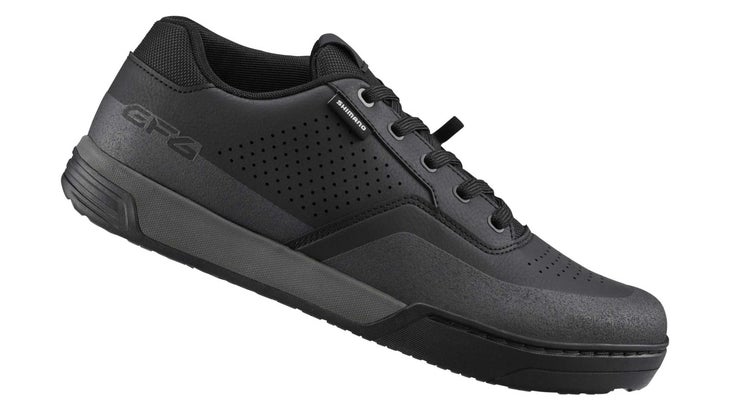
Most Streamlined
Shimano GF6
$160 at Backcountry $160 at Amazon
Retention system: Laces
Available sizes: 38-48 (unisex)
Pros and Cons
⊕ Matches grip with Five Ten’s Stealth rubber
⊕ Stiff enough for long trail rides
⊗ Not quite burly enough for pure park riding
Featuring Shimano’s Ultread GF rubber, a torsional midsole that Shimano calls their Torbal 2.0 midsole, and trail-ready design, the GF6 is their premier flat pedal shoe. While the shoe has minimal padding compared to others we tested, there is enough to handle the accidental rock kicks and moderate impacts.
Fitwise, it had good heel retention both on and off the bike. More importantly, we found the grip on par with the Five Ten’s, and they’re stiff enough to handle long rides without undue foot fatigue. Shimano footwear tends to fly under the radar for some reason, but they make an excellent product, and we’d love to see them out on the trails more. The fit and features make this my go-to flat pedal shoe.
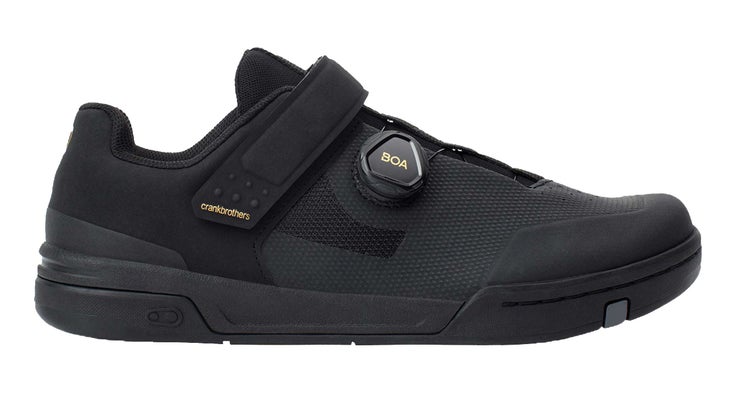
Most Stylish MTB Shoe
Crankbrothers Stamp BOA Flat
$180 at Backcountry $180 at Competitive Cyclist
Retention system: BOA
Available sizes: 5-14 (unisex)
Pros and Cons
⊕ Easy walking off the bike
⊕ Stiff enough for long rides
⊗ Match MC2 rubber not as grippy as others
The Stamp BOA Flat is a stylish option that features a BOA dial, Velcro power strap, Match MC2 rubber, and a relatively stiff sole for power transfer. The Stamp BOA is stiff, but not too stiff; there’s just enough flex for easy walking—although they did feel a hair tight in the forefoot for a couple testers.
The Match MC2 rubber was grippy, though it’s not Stealth grippy, so if you’re going to be riding on wet days or have trouble locking to your pedals, look elsewhere. We’re not 100 percent sold on BOA systems in terms of fit, but we do relish the ability to securely snug up shoes without the litter of laces.
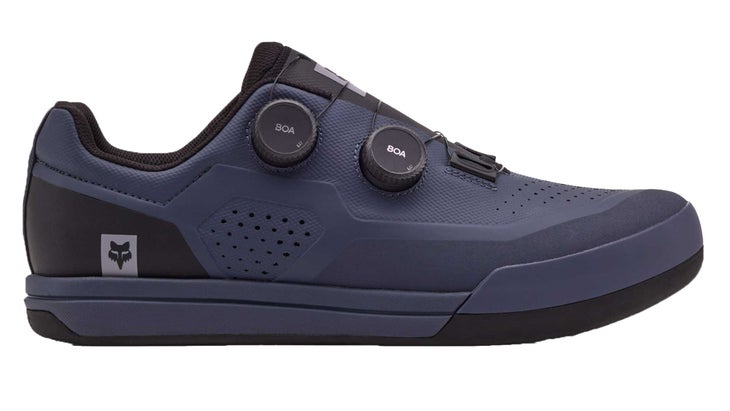
Best Clipless MTB Shoe
Fox Racing Union BOA
$250 at REI $250 at Backcountry
Retention system: Boa Li2
Available sizes: 37-47
Pros and Cons
⊕ Great in-between profile
⊗ Spendy
Best known for helmets, body armor, and apparel, Fox Racing recently entered the mountain bike footwear market and the Union BOA is the brand’s premier clipless mountain bike shoe, designed for trail riding and enduro racing.
It utilizes a pair of BOA Li2 dials to adjust the fit tension and a lightweight nylon shank to stiffen the sole while pedaling. At 221 grams per shoe (size 42), the Union BOA is lighter than similar “skate-style” mountain bike shoes, but heavier than svelte shoes designed for cross-country racing. On the trail, we found it provided ample support, and the micro-adjustable dials are handy for on-the-fly adjustments.
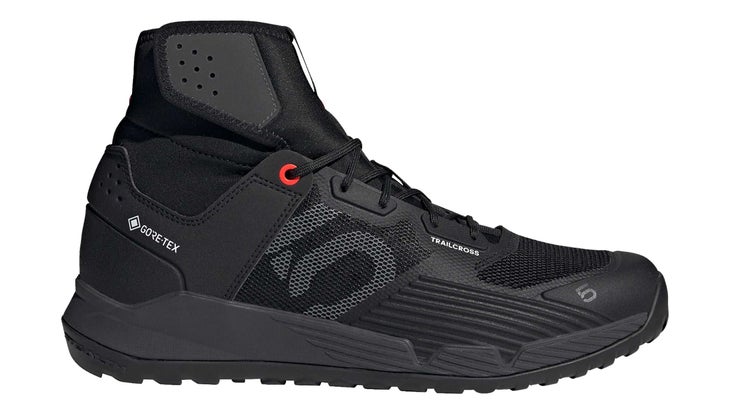
Most Waterproof
Adidas Five Ten Trailcross Gore-Tex
$220 at REI $220 at Backcountry
Retention system: Laces
Available sizes: M4/W5-M14/W15
Pros and Cons
⊕ Iconic grip
⊕ High cuff keeps out debris
⊗ Water can still come in through the top
Mountain biking can be dirty work. If you’re looking for a shoe to accompany you on wet-weather rides, look no further than Five Ten’s Trailcross Gore-Tex. The shoe’s waterproof upper shrugs off rain and trail spray while Five Ten’s legendary Stealth Phantom Rubber provides extra grip on slippery trails.
Like other waterproof mountain bike shoes, this model is not impervious to water running down your leg, into your sock, and then getting trapped within, so it’s best to pair them with water-resistant pants when riding in sloppy conditions.
How To Choose Bike Shoes
Cycling shoes can be segmented into categories based on their intended use and cleat interface.
Cleats/Clipless Shoes
Road cycling shoes are typically compatible with composite-based, three-bolt style cleats like Shimano’s SPD-SL and Look Delta/Keo. These cleats offer a high amount of retention and have a greater surface area to maximize stability and power transfer per pedal stroke, which is ideal for road cycling. However, the cleats are often exposed and provide poor walkability.
Gravel shoes use a two-bolt pattern for use with cleats like Shimano’s SPD. Two-bolt cleats are generally smaller and made of metal, offering greater durability for walking on uneven surfaces.
Flats
More and more mountain bikers are ditching clipless bike shoes in favor of flats, shoes with sticky rubber soles that offer good grip on pedals and don’t require you to clip in/out of pedals. Many experienced riders and downhillers who navigate high-consequence terrain prefer flats because they allow you to bail off your bike more easily.
Flat shoes are also better choices for novice riders, since they don’t come with a learning curve (getting the hang of clipless shoes and cleats can be tricky). The downside to flats is they don’t offer the same power transfer as clipless shoes.
Budget Versus Performance
Don’t disregard your budget. Bike shoes can be exorbitantly expensive, especially on the high-performance end of the spectrum. If you’re looking to get into racing, the higher price tag might be worth it for every additional watt of power. If you’re not racing, we recommend leaning to the more comfortable end of the spectrum, rather than trying to maximize stiffness and performance; these shoes generally come with more palatable price tags.
Materials
Road biking shoes feature lightweight soles made up of carbon or composite materials that blend stiffness and compliance to best suit the rider’s needs. A stiffer sole generally provides higher power transfer; a more compliant shoe flexes more and provides a more comfortable ride, but often equates to more power loss.
Gravel and mountain bike shoes add tread around the sole to improve walkability and stability.
Shoe uppers will consist of a microfiber or knit material with varying amounts of suppleness, ventilation and foot/ankle support. Microfiber uppers tend to provide more durability and support, while knit uppers have a greater amount of ventilation and suppleness.
Fit
Fit is critical in a cycling shoe and directly impacts performance. If you can, try before you buy. Your local bike shop may have a selection of bike shoes and employees with a wealth of experience to help you find the right fit. Call around to see what’s available and visit your local bike shop to get a real feel for the shoes before you commit.
How We Test
- Number of products tested: 21
- Number of Testers: 8
- Number of miles collectively ridden during testing: 12,000
- Biggest ride: 110 miles
Our group of testers, made up of men and women across the country, put 21 pairs of the year’s newest road, gravel, and mountain bike shoes to the test on various rides, races, and trails. Some testers assessed a shoe’s performance while preparing for marquee road and gravel events, while others set out to determine a shoe’s comfort and versatility on their weekly coffee ride. Our primary testing ground for MTB shoes was mountain biking mecca Hood River, Oregon, where we assessed a shoe’s performance on everything from technical, muddy trails to mellow, meandering cruisers. We graded each pair of shoes we tested on characteristics like stiffness, weight, comfort, and functionality. The shoes on this list impressed our crew in all departments.
Meet Our Lead Testers
David Kennedy has been riding road and gravel bikes for 15 years and has been writing about the latest tech in the sport since 2017. He’s toed the line at premier road and gravel events nationwide, including the Belgian Waffle Ride San Diego and the Unbound 200. When he’s not writing or riding, he’s pulling apart bikes at his local shop and connecting with the diverse cycling community around his hometown of Los Angeles.
Nikki Rohan has been mountain biking for close to 20 years, and testing mountain biking gear for Pinkbike for almost a decade. She resides in Hood River, Oregon, with her husband, two teenagers, a 1-year-old, two dogs, and a grumpy cat. When she is not working, cooking, or parenting, you will find her biking on the local trails.
Josh Patterson has been riding and wrenching on bikes for 20 years and, with a master’s degree in journalism, has been writing about the sport for over half of that time. He’s a cycling generalist who finds joy in riding road, gravel, and mountain bikes, which made him the ideal candidate to manage Outside’s Gear Guide bike coverage for the past four years. He grew up in the Flint Hills of Kansas and was an early adopter of gravel racing and participated in the first Unbound 200. He’s now based in Fort Collins, Colorado.
